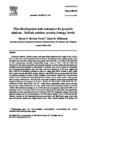Diet development and evaluation for juvenile abalone, Haliotis asinina: protein/energy levels

ຄົ້ນຫາ / ເປີດ
Request this documentວັນທີ
1999Page views
168Metadata
ເບິ່ງບັນທຶກລາຍລະອຽດລາຍການCited times in Scopus
Share
ບົດຄັດຫຍໍ້
Juveniles of abalone, Haliotis asinina with mean initial weight and shell length of 0.6±0.03 g and 15±0.07 mm were fed practical diets for 90 days. The practical diets contained graded levels of protein from fish meal, shrimp meal, and soybean meal at 22 (diet 1), 27 (diet 2), and 32% (diet 3) with corresponding estimated metabolizable energy values of 3254, 3150, and 3090 kcal ME/kg diet. The amino acid profile and proximate analyses of muscle meat of the test animal and published nutrient requirements of other species of Haliotids were used as a basis for formulating and developing these practical diets. The diets were fed to abalone at 2–5% body weight once daily (1600 h) for biological evaluation in terms of weight gain (WG), increase in shell length (SL), specific growth rate (SGR), protein efficiency ratio (PER), feed conversion ratio (FCR) and for physical evaluation in terms of shell coloration of the animal. Natural food, Gracilariopsis bailinae (17% CP/2200 kcal ME/kg) (NF) fed ad libitum served as the control. Better growth rates, in terms of WG and SL, FCR and PER were noted in abalone fed the three formulated diets compared with those fed seaweed, G. bailinae. Abalone fed diets 3 (WG: 347%; SGR: 0.81; SL: 140%) and 2 (WG: 307%; SGR: 0.70; SL: 139%) showed significantly better growth rate than those fed diet 1 (WG: 252%; SGR: 0.51; SL: 132%). Natural food-fed abalone had the lowest WG (134%), SGR (0.06) and increase in SL (77%). Survival was generally high at 85–95% for all treatments. FCR (1.5–2.3) and PER (2.19–2.47) for animals fed the three diets were significantly better than for those fed natural food (0.10 PER and 6.98 FCR). Regression analysis showed the optimum protein level for juvenile abalone to be 27% with an energy level of 3150 kcal/kg ME. Abalone juveniles fed the formulated diets produced shells with light bluish green color while those fed seaweed retained the original brown color. Diet 2 which contained 27% protein, 5% lipid and 40% carbohydrates with an energy value of 3150 kcal/kg ME may be used as a basal diet for the rearing of juvenile abalone, H. asinina.
Suggested Citation
Bautista-Teruel, M. N., & Millamena, O. M. (1999). Diet development and evaluation for juvenile abalone, Haliotis asinina: protein/energy levels. Aquaculture , 178(1-2), 117-126. https://doi.org/10.1016/S0044-8486(99)00121-0
ວິຊາ
Collections
- AQD Journal Articles [1215]

